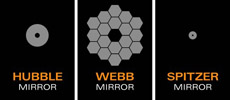JWST Overview
JWST's primary mirror will have a diameter of 6.5 meter. In order to be foldable, which is necessary for its transport into orbit, the mirror is divided into 18 segments of comb-like shape.
To keep an operating temperature of 8K, the telescope has to be shielded from thermal radiation coming from the sun and the earth. Residing at the L2 Lagrange point, a large sunshield (unfolded: ca. 650 m2) seperates the telescope into a sun facing side with a temperature of around 80K and a cold anti-sun side.
Instruments:
- NIRCam: The Near Infrared Camera will provide Nyquist-sampled imaging at 2 and 4 microns. Overall it will cover a wavelength range from 0.6 to 5 microns. 2.2' x 4.4' FOV imaging for one wavelength will be possible with two identical imaging modules so that two wavelengths are observable simultaneously via dichroics.
- NIRSpec: The Near Infrared Spectrograph will be a spectrograph for the wavelength range of 0.6 to 2.3 microns. NIRSpec will provide 3 observing modes, a low resolution (R=100) resolving power prism mode, an medium resolution (R=1000) multi-object mode and an high resolution (R=3000) integral field unit or long-slit spectroscopy mode. For all modes (except the long-slit spectroscopy) the field of view will be 3.4 x 3.4 arcmin. At R=100 one prism spectrum covers the full 0.6 to 5 micron wavelength range. At R=1000 three gratings cover the wavelength range from 1-5 microns.
- MIRI: The Mid Infrared Instrument will provide imaging and spectroscopy over a 5 to 25 micron wavelength range. Its design consists of two main modules, an imager and an integral field unit (IFU) spectrometer. The integral field spectrograph will obtain spectral and spatial data simultaneously on a relatively compact region of the sky. Its design uses four image slicers to provide R=3000 integral field spectroscopy over a 5-25micron wavelength range. The IFUs provide 4 simultaneous fields of view, ranging from 3.0 x 3.9 arcsec2 with increasing wavelength, with pixel sizes ranging from 0.2 to 0.65 arcsec. The spectrograph uses two 1024 x 1024 pixels Si:As detector chip assemblies. The MIRI imager will allow broad and narrow band imaging, phase-mask coronagraphy, Lyot coronagraphy and prism low resolution (R=100) spectroscopy from 5 to 10 microns. All modes will use a single 1024 x 1024 pixels Si:As detector. The imager will be diffraction limited at 6 microns with a pixel scale of 0.11 arcsec and a field of view of 112 x 76 arcsec2.

The MIRI European Consortium
MIRI is developped in an international partnership (50 / 50) between JPL and a nationally funded consortium of European institutes, working with ESA and NASA. This consortium consists of 21 institutes, spread over all Europe. The 1st Institute of Physics of the University of Cologne contributes to MIRI with the flight-hardware of the LRSDPA and is part of the test team that is in charge of evaluating the performance of MIRI.
